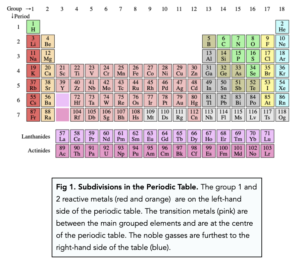Periodic Table Metals vs Non-Metals (GCSE Chemistry)
Periodic Table Metals vs Non-Metals
Metals and Non-Metals
The metal and non-metals in the periodic table can be further subdivided. Below we will discuss these divisions and the physical and chemical properties that group them.
Group 1 and 2 metals
Metals in groups 1 and 2 are known as the reactive metals. During a reaction, elements in Group 1 lose 1 electron and all react in the same way. All elements in Group 2 elements lose 2 electrons and react in the same way.
We will learn more about the reactions that Group 1 and 2 elements undergo soon. Here is a brief overview of the reactive metals’ properties:
- They react vigorously with other elements such as oxygen and chlorine.
- They react with water to form alkaline solutions and are also known as alkaline metals.
- They are soft and can be cut very easily with a knife.
Transition Metals
Transition metals are the blocks of elements found between groups 2 and 3, in the centre of the periodic table. These are the elements that most people associate the world metal to such as copper, iron and silver. They are very strong, good conductors of electricity and heat.
Group 0
Non-metals in Group 0 are also known as noble gases. These elements do not react easily and this is because they have a full outer shell of electrons. We will learn more about transition metals and their properties in a later tutorial.






Still got a question? Leave a comment
Leave a comment